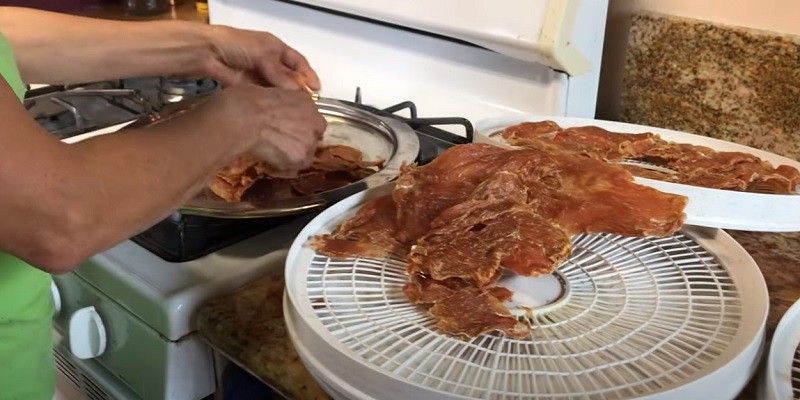Last Updated on April 23, 2025 by Pauline G. Carter
To dehydrate chicken for dog treats, start by boiling or baking the chicken until fully cooked. Then, slice the chicken into thin strips or small chunks and place them on a dehydrator tray.
Set the dehydrator to 140°F and allow the chicken to dry for 8-12 hours until it becomes dry and leathery. Once dried, let it cool before giving it to your dog as a tasty treat. Dehydrated chicken dog treats are a healthy and cost-effective option for rewarding your canine companion.
Not only do they provide a great source of protein, but also they can help improve dental health by reducing plaque and tartar buildup. By following a few simple steps and utilizing a food dehydrator, you can create delicious, homemade treats that your dog will surely love. Additionally, making your own dehydrated chicken treats allows you to ensure the quality and safety of the ingredients, giving you peace of mind.

Credit: spoiledhounds.com
The Dehydration Process
Dehydrating chicken for dog treats is a simple and effective way to provide your furry friend with a healthy and delicious snack. Understanding the dehydration process is essential to ensure that the treats are properly prepared and safe for consumption. Dehydration involves removing moisture from the chicken to preserve it, extending its shelf life, and concentrating its flavor. This process not only ensures that the treats are safe for your dog but also helps retain the nutritional value of the chicken.
Importance Of Dehydrating Chicken For Dog Treats
Dehydrating chicken for dog treats is important for several reasons. First and foremost, it helps to eliminate the moisture content in the chicken, which is crucial for preventing bacterial growth and spoilage. By removing the moisture, you are creating an environment where bacteria cannot thrive, ensuring that the treats remain safe for your dog to consume. Additionally, dehydrating the chicken allows you to create a shelf-stable product that can be stored for an extended period, providing a convenient and long-lasting snack for your pet.
Benefits Of Homemade Dehydrated Chicken Treats Over Store-bought Treats
- Quality Control: When you prepare homemade dehydrated chicken treats for your dog, you have full control over the ingredients and can ensure that only high-quality, nutritious chicken is used.
- Additives and Preservatives: Homemade treats allow you to avoid the additives and preservatives often found in store-bought treats, providing a healthier option for your pet.
- Cost-Effective: Making your own dehydrated chicken treats can be more cost-effective in the long run, especially if you have multiple furry friends to treat.
- Tailored to Your Dog’s Needs: Homemade treats can be tailored to your dog’s specific dietary requirements and preferences, providing a personalized snack option.
Choosing The Right Chicken Cuts
When considering how to dehydrate chicken for dog treats, selecting the right chicken cuts is crucial. The quality and type of cuts will impact the dehydration process and, ultimately, the overall treat quality.
Selecting High-quality Chicken Cuts For Dehydration
High-quality chicken cuts are essential for dehydrating chicken for dog treats. Opt for fresh, lean cuts of chicken, free of additives and preservatives. Boneless, skinless chicken breasts are a popular choice due to their low-fat content and relatively uniform thickness. Meanwhile, chicken thighs also work well, providing a slightly higher fat content that can add flavor and moisture to the final treats. It is important to source chicken that meets food safety guidelines to ensure the health and well-being of your pets.
The Impact Of Different Cuts On Dehydration And Treat Quality
The type of chicken cut selected plays a significant role in the dehydration process and the quality of the resulting dog treats. Boneless, skinless chicken breasts are relatively easy to work with due to their consistent thickness, resulting in more uniform dehydration. On the other hand, chicken thighs may require additional care due to their varying thickness and could result in inconsistent dehydration if not prepared properly. Understanding the characteristics of each cut is essential for achieving desirable treat quality.
Preparing And Dehydrating The Chicken
When it comes to providing your furry friends with healthy and tasty treats, dehydrated chicken is a popular option that offers numerous benefits. Preparing and dehydrating chicken for dog treats is a simple process that allows pet owners to ensure the quality and safety of the snacks they give to their beloved pets. In this guide, we’ll explore the proper cleaning and trimming techniques for chicken preparation, dehydration methods using an oven, dehydrator, or air-drying, and essential safety tips for handling and storing dehydrated chicken treats.
Proper Cleaning And Trimming Techniques For Chicken Preparation
Before beginning the dehydration process, it’s crucial to properly clean and trim the chicken to ensure the safety and quality of the treats. Here are the essential steps for preparing the chicken:
- Thoroughly wash the chicken under cold running water to remove any dirt or debris.
- Pat the chicken dry with paper towels to remove excess moisture.
- Trim off any excess fat and remove the skin, as these parts can become rancid during the dehydration process.
- Cut the chicken into small, uniform pieces to ensure even dehydration.
Dehydration Methods: Oven, Dehydrator, Or Air-drying
There are several methods for dehydrating chicken, each with its own advantages. Whether you choose to use an oven, dehydrator, or opt for air-drying, here’s a brief overview of each method:
| Dehydration Method | Advantages |
|---|---|
| Oven | Convenient for those without a dehydrator, relatively quick process at low temperatures. |
| Dehydrator | Precise control over temperature and airflow, ideal for consistent and efficient dehydration. |
| Air-drying | Natural method, requires minimal equipment, and can be suitable for smaller batches of chicken. |
Safety Tips For Handling And Storing Dehydrated Chicken Treats
Ensuring the safety of dehydrated chicken treats is paramount to prevent any potential health risks for your pets. Here are some essential safety tips to keep in mind:
- Store dehydrated chicken treats in airtight containers to prevent spoilage and maintain freshness.
- Avoid cross-contamination by thoroughly cleaning all utensils and surfaces used in the preparation and dehydration process.
- Monitor the treats for signs of spoilage, such as mold or off-putting odors, and discard any treats that show these signs.
- Refrigerate or freeze dehydrated chicken treats for longer shelf life, especially if you’ve made large batches.
- Always wash your hands thoroughly after handling raw chicken to prevent the spread of bacteria.
Creating Delicious And Nutritious Chicken Dog Treats
Dehydrated chicken dog treats are not only a tasty reward for your furry friend but also a healthy and nutritious snack. By preparing homemade dehydrated chicken treats, you can ensure that your canine companion is getting the best quality ingredients without any harmful additives. Here’s how you can create delicious and nutritious chicken dog treats using simple and safe methods.
Adding Flavors And Nutrients To The Dehydrated Chicken Treats
When dehydrating chicken for dog treats, you can enhance the flavor and nutritional value by adding various ingredients. Incorporating fresh herbs, such as parsley or cilantro, can introduce new flavors and provide additional health benefits. You can also include nutrient-rich vegetables like sweet potatoes or carrots to boost the treat’s nutritional content. Consider sprinkling a small amount of turmeric for its anti-inflammatory properties.
Ensuring The Treats Are Safe For Canine Consumption
It’s crucial to prioritize your dog’s safety when preparing dehydrated chicken treats. Use high-quality, fresh chicken meat and ensure proper hygiene during the preparation process. Avoid seasoning the chicken with ingredients that are toxic to dogs, such as onion and garlic. Thoroughly cook the chicken before dehydrating to eliminate any harmful bacteria, and always store the treats in an airtight container to prevent contamination.
Storage And Shelf Life Of Homemade Dehydrated Chicken Dog Treats
Proper storage is essential to maintain the quality and shelf life of homemade dehydrated chicken dog treats. After dehydrating the chicken, allow it to cool completely before storing it in an airtight container. Ensure the treats are kept in a cool, dry place away from direct sunlight to prevent spoilage. When stored correctly, homemade dehydrated chicken dog treats can typically last for several weeks. Regularly inspect the treats for any signs of spoilage and discard them if they appear moldy or off-smelling.
Frequently Asked Questions Of How To Dehydrate Chicken For Dog Treats?
Can I Dehydrate Chicken At Home For Dog Treats?
Yes, you can easily dehydrate chicken at home to create healthy dog treats.
What Are The Benefits Of Dehydrated Chicken Dog Treats?
Dehydrated chicken treats are a natural, protein-rich, and wholesome option for dogs.
How Long Does It Take To Dehydrate Chicken For Dog Treats?
Generally, it takes around 6-8 hours to dehydrate chicken into tasty dog treats.
What Equipment Do I Need To Dehydrate Chicken For Dog Treats?
You’ll need a dehydrator or an oven, as well as a sharp knife and cutting board.
What Are Some Seasoning Options For Dehydrated Chicken Dog Treats?
You can sprinkle the chicken with parsley, turmeric, or a bit of rosemary for flavor.
How Should I Store Dehydrated Chicken Dog Treats?
Store the treats in an airtight container in a cool, dry place to maintain freshness.
Conclusion
Incorporating dehydrated chicken into your dog’s diet is a beneficial and straightforward way to provide them with natural, healthy treats. By following the proper steps for dehydration, you can ensure that your dog receives the best quality treats. With a small amount of effort, you can give your furry friend a tasty and nutritious reward.

